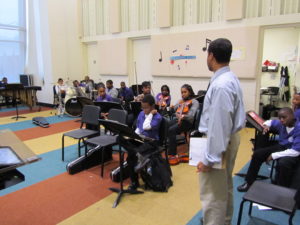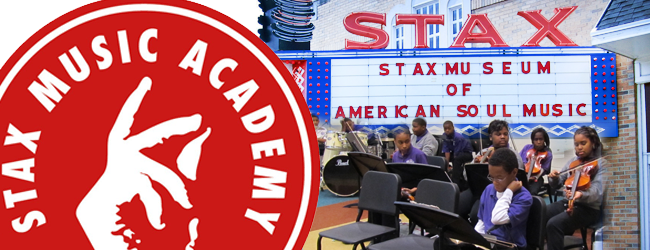Stax Records created a mecca of Soul Music in Memphis that acted as the de facto anthem for an entire generation of change and unrest in the 1960s. The recordings that came from the label were nothing short of epic, and made an immeasurable impact on music as we know it. Nearly fifty years later, Stax is again manufacturing great music, this time through it’s highly focused, world-renown school. The Stax Music Academy in Memphis sits adjacent to the Stax Museum of American Soul Music, and teaches a curriculum on par with the best music schools in the country. While the museum pays homage to the likes of Otis Redding, Isaac Hayes and many other Stax legends, the academy next door shapes students into blossoming musical prodigies, who are no doubt destined to be legends in their own rite. Stax Academy is a southern jewel, fostering a highly focused musical growth in children, many of whom were at-risk in the community. Walking through the halls of the Stax Music Academy, one can hear students playing scales on Viloins and practicing harmonies, while others are studying the intricacies of algebra and equally important school subjects. This is the modern face of Stax music; a place that continuously shapes genuine musical talent into lifelong skills.

In the 1960s and 70s, Stax Records was the quintessential record label, singlehandedly creating an entire genre and style of music aptly called Soul. Out of the famous Stax building, a renovated theater, came some of the most influential names in music in the last 100 years. Otis Redding, Sam Cooke, Rufus Thomas, Booker T. and the MGs, the Bar Kays, Albert King, Isaac Hayes, and dozens of others made up the Stax repitoire. Stax was a dynamic, multi-million dollar, hit-making machine for nearly two decades. Ultimately, lawsuits, poor distribution, and financial trouble ended Stax’s mammoth reign over music in the late 1970s. Stax headquarters, the famous renovated theater at 926 East McLemore Avenue, was eventually demolished and the master copies of songs, along with the Stax name, were sold off. For years the Stax legacy only lived in the countless artists and songs that were influenced by it’s many amazing musicians. In the early 2000s, however, a plan evolved to revive Stax with the goal of recreating the magic, the music, and community enrichment that it represented, and in the process, revitalizing a a badly deteriorated neighborhood in need. “These anonymous philanthropists just thought that this neighborhood deserved it, and that people had just forgotten what Stax was“, says Tim Sampson, Communications Director at Stax Museum of American Soul. “They said if we’re going to do anything, we’re going to do something for the kids in that area, because they have nothing… Because this neighborhood used to be cool, and all these people from this neighborhood and all this great music used to go on here.” The Stax building was rebuilt to the exact blueprints of the original, and a beautiful, state of the art adjacent building was created with the goal of teaching music to neighborhood children who desperately needed the structure and direction that music could provide. Now, the music school has 60 students, and the charter school, which acts as college preparatory, has around 400 students. “The academy’s great”, says Sampson. “90% of the kids attend via scholarships. We require their families to pay 10% of the tuition, which is about $80 a year.”

The journey so far has been a highly successful one. “In the past two years, all of the Music Academy students have been accepted to college. Which is our bottom line goal with all the kids we work with, so we’re just ecstatic about that.” says Sampson. The academy is now doing instrumental and vocal education, teaching music theory and songwriting, production and composing, among many other things. They regularly bring in music professionals to do workshops, and modern Jazz great Kirk Whalum is currently the standing CEO. The academy works directly with the Berkley College of Music curriculum and now sports a state of the art Apple computer lab. In addition, the academy now has three full time teachers on staff, including a music director who teaches Jazz and rhythm section ensemble, a percussion master, and an opera-singing vocal coach. The students of Stax Academy have played across the world, recently performing in Italy, Australia and Europe. Last July 4th, the students performed a prestigious show at the Kennedy Center in Washington DC. They’re scheduled to play the Smithsonian this upcoming 4th of July.
As the students diligently play chords and practice singing parts, support for the academy continues to pour in. Huey Lewis and the News recently recorded an entire album of Stax covers, and while we were touring the magnificent facility, a check came in from The White Stripes, a favorite around American Blues Scene, for nearly $4,000 to aide the Stax Academy. Of course, a continuously growing operation such as the Stax Academy needs all of the support it can get in order to continuously bring the kind of high-level musical education the children deserve. Ultimately, the anonymous souls who first donated the funds to begin the academy had a goal of revitalizing the neighborhood, and there is strong evidence that they’re doing exactly that, and much more. A beautiful new shopping center has recently been constructed across the street, the Stax Academy is deep into construction of a new facility that will more than double the space, in order to accommodate their exploding charter school, and tourists continue to pour into the museum, gawking over Albert King’s trademark Gibson Flying V guitar and the late Isaac Hayes’ highly customized blue Cadillac.
The ultimate goal of the Stax Academy is to be placed on par with Juilliard and other prestigious music schools, and as a result, children from the neighborhood are now not the only ones now vying to get in; people from all over the region hold the Stax Academy in the highest regard. As the school continues to flourish and the students continue to grow, both in music and life, Stax Music Academy will no doubt continue to produce talented lifelong musical scholars. The music, transcending racial and socio-economic issues of the day, was what made Stax a magical place 50 years ago, and the music is what is once again reuniting the neighborhood and helping to vitalize a town. This is a fact that most certainly makes all of those who were involved in Stax Records proud, and continues to ensure the legacy and message of all of the Stax artists that have passed on.

